Wednesday March 16, 2016
For: Big bang for your buck, surprisingly good chassis, characterful engine.
Against: Tacky interior, expensive to feed, could be a bit sharper.
Score: 4.4/5
By Richard Bosselman
BURGERS, bourbon, Levis, drive-through weddings and funerals, JFK, gun culture, disco, James Dean, Neil Armstrong, bubble gum, Bugs Bunny, the Brady Bunch, Britney and the Fonz … American has given the world so much, right?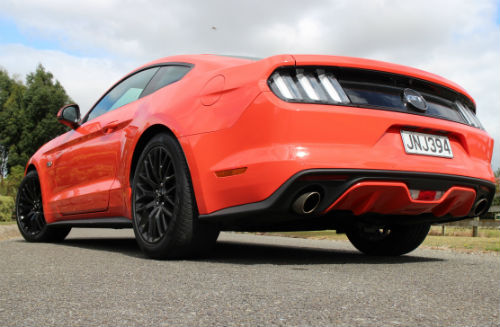
Now, a mere 50 years after they starting producing it, they’ve finally gotten around to producing their most enduring automotive icon, the Mustang, in right-hand drive. Will miracles never cease?
Is this exciting or not? Actually, yeah, it is.
I can’t say I’m especially ‘into’ big American muscle cars yet attending the global launch of this car, staged in California about 16 months ago, was one of the highlights of 30 years-plus spent writing about cars. Maybe because it’s the second-most famous car (after the Model T) built by one of THE famous brands of autodom. And maybe, too, because there’s just something about the Mustang …
Admittedly, it’s a special ‘something’ that resonates most loudly from one particular member of the herd Ford New Zealand has corralled.
While the distributor should be applauded for trying to play a broad field in delivering the latest car in 2.3-litre EcoBoost format as an alternate to the 5.0-litre eight-cylinder, and is testing the water with the convertible as well as the coupe – and, of course, is front-and-centring with a six-speed auto ahead of the more traditional like-cog-counted manual - fact is one factory-provided version rates higher than the rest with the purest fan base.
The sound and the badge give the $74,880 V8 coupe on test here an extra credibility over the alternate four-cylinder, regardless that the latter is perhaps better value on a cash per kilo outlay – given it’s got the look and is surprisingly frisky.
Style, specification
Let’s pop a few bubbles. Blue jeans actually originally came out of renaissance Europe and Levi Strauss didn’t actually invent the modern version; a business partner can claim that honour. Fast food franchises? They go back thousands of years … there’s solid evidence going back to the Roman Empire. Henry Ford didn’t invent the assembly line, The Star Spangled Banner was a British drinking song (the flag’s not an as American as they claim, either) and .. damn it all, the Mustang is just another car.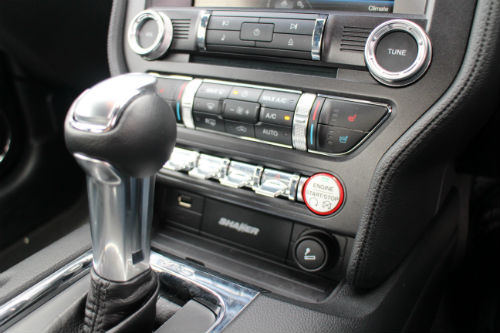
Except it isn’t. Not wholly. Mustang styling has changed considerably over the years, for a while for the worse, but with this edition they’ve wisely wound back the clock and eye-picked from several cars out of THE classic period: the second part of the 1960s and first years of the 70s. Back then we’d been through the classic first generation – a design that simply cannot and should not be replicated - and gone to shapes like the Mach 1, a car that that had bulked up a bit, though hadn’t gone fully to fat.
Left-hand import allowance means the Mustang colony is quite decently-sized here, yet this latest shape car – which conceivably cannot be imported in the same formats chosen by Ford NZ – still stands out from that crowd. It really knows how to make an entrance.
The square-jawed, wide and hunkering, XXL-sized shape grabs attention, so too the sound and some of the special features: Unlock the car at night and the puddle lights beneath the mirrors display running horse silhouettes on the ground.
So it’s no stranger to subtlety, then. Personally, I’d stop short of the test car’s ‘Competition Orange’ (‘Triple Yellow’ seems a touch too brash, too). Make mine in Titanium silver. Mind you, my wife and quite a few friends – and it’s amazing how many of them turn up when they learn there’s a Mustang in the hood – reckoned the test car look peachy. Guess my medallion just isn’t big enough.
There’s actually not too much embellishment with the bodywork – just a wee lip on the boot and a bit of a bib spoiler - and interestingly you cannot pick the four- and eight-cylinder cars from a distance; they even run the same 19-inch spoked alloy. Picking them part comes down to close scrutiny of the badges: the flagship model has ‘GT’ and ‘5.0’ badges on the boot and front wings and the boot medallion has a prancing horse on it. You can also tell it from the Brembo brakes and a set of ‘power bars’ in the grille.
Reference to this being a ‘blue collar’ car makes sense when the interior is scrutinised. Its flashy, quite extravagant but not as expensive as first glance suggests. Mismatched switchgear, too many unconvincing metal-look plastic finishes, chunky panels, mass market plastics … it’s all a bit Kwik-E-Mart yet not so poor as to be a turn-off.
Assembly isn’t too bad. I’ve driven brand-new American cars in which whole doors trims have fallen off. Even after 7000 kilometres (probably hard-driven) kilometres, the test car was rattle-free. But yeah, though Ford is at pains to point out this car is a big step forward in quality over its predecessor, the reality is that at this price there’s, well, a price.
The bulky exterior doesn't add up to a roomy interior; it’s a four seater in spirit only, best-suited to carrying a driver and front-seat passenger; anyone stuck behind will feel seriously hemmed in, with a low roof and zero kneeroom if the driver is tall.
There aren't that many cubbies around the cabin, either, and though the boot is a good size at 407 litres, it’s not especially easy to access, due to the high lip.
Power, performance
Ford likes to suggest the big news for the Mustang is that is has adopted a four-cylinder turbo engine, mainly to cut the CO2 emissions and help it appeal to a whole new range of buyers.
Well, yeah, we ALL want to save the world. But, ask yourself this? When you go to a Mustang owners’ club display, hire a Pony car on a trip stateside or head to a dealership for some touchy-feely time, what’s the engine you REALLY want to experience? Exactly. The four’s not short on power (it’s the same unit going into the new Ford Focus RS hot hatch) and actually sounds okay, but if you’re out to cash into maximum emotional experience, only the V8 will do.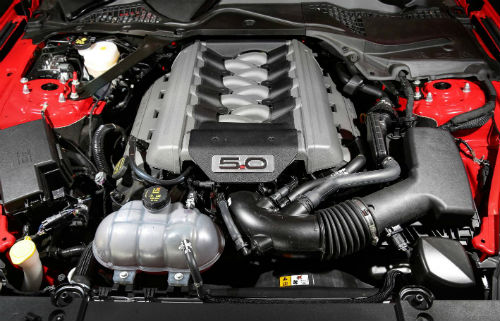
Is it grunty enough to offer a full muscle car experience? Cited outputs of 306kW and 530Nm place it behind the Falcon XR8, whose FPV-developed supercharged edition of the same 5.0-litre smacks out 335kW and 570Nm, and your Holden mates will waste no timing reminding their current hero, the SS-V Redline, has 304kW and 570Nm. And that it’s a 6.2-litre.
But like they say, it’s never the size of the dog in the fight … the chat about it being a bit weak on paper and about how much of the engine noise is real and how much is enhanced, if not outright synthesized (not an argument I’m getting into), does tend to die away when you get in the thing and give it a bootful.
Suddenly, there’s concensus that, actually, the Mustang feels and sounds mighty fine.
It’s not Bullitt fast: For that kind of action you need spend extra on those Roush or Shelby kits. But even though the cited 0-100kmh time of five seconds flat is more appropriate to the manual than the auto on test, there’s a definite muscle car authenticity to how it raises that nose and bellows toward the horizon when the throttle is buried.
Obviously there is a downside to owning a massive, thunderous V8, and it's no surprise to say that the Mustang returns some fairly ruinous economy. The 15.5-litres per 100km average registered by this car during my week gave truth the age-old saying that, when you hit the throttle, cars of this ilk do tend to hit the bottle. Even so, don’t think that it was being driven in police chase mode all of the time. For the most part, the car was operated with due deference to the laws of the land. And even then it was still sucking through the juice. Which, by the way, is the good stuff … nothing but 95 octane or better for this beast.
Driving
In addition to the right-hook configuration, this generation six Mustang also delivers something else new: An independent rear suspension. All previous factory versions were on a live rear axle, which probably explains why wrecking yards throughout America are overflowing with wrecked ‘Stangs. The old set-up was brilliant for street drags – a popular homeland weekend past-time – but it did tend to make it a difficult car to drive when pushing on through the bends.
The adoption of that multi-link rear axle suspension, plus the allowance for export cars to have different – generally firmer - spring and damper settings than the car takes Stateside delivers some real benefit.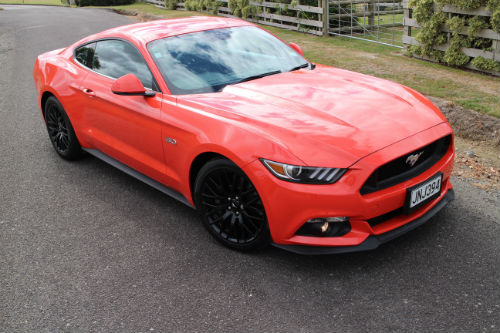
I’ve driven one or two old Mustangs and I’ve also driven this model in its American market format; assuredly, the set-up that arrives here makes a tangible difference for good. It’s sharper in the steering and sits flatter through bends than the US-market equivalent and is a thousand-fold better than the historic jiggers.
So good that you’d swear this wasn’t an American car? Erm, I’m not sure I’m quite ready to suggest that.
This is more a cruiser than an outright racer; although those Brembo brakes provide fantastic stoppability, I’m not suggesting ready for the next Targa in as is’ state.
More suspension work is required to get the handling to scapel sharpness; at the moment it’s more like one of those mega-sized bowie knives you get at a top-level steak restaurant; the kind that effortlessly slices through a giant sirloin.
Yet even though the excitement here is more to do with straight-line V8 muscle than any cornering incisiveness, it really does lift the game nonetheless.
Though the car’s weight does show on a very challenging road, but those Pirelli tyres – top shelf P-Zeroes – and the chassis together generate a serious amount of useable grip in corners and it also benefits from having a limited-slip differential.
The ride is firm, and the different modes that affect the amount of stability and traction control – despite it’s tag, ‘Race’ is actually quite good for the road – also alter the experience. Even though I didn’t try the launch control, I’m still a bit aggrieved requirement to meet Australian regulation (our markets share a common spec) means we miss out on the ‘line locker’ function that allows it to wheelspin on the spot.
Overall, though given that it comes with two sizeable realities – the weight, a touch under 1800kg, and the size (at nearly five metres long and almost two metres wide, the Mustang really is BIG for two-door car) – it doesn’t acquit too badly at all.
You can certainly make better use of more of that power, for more of the time, than in the previous models. It would be interesting to measure it against Holden’s Commodore SS-V Redline, which for me sets the dynamic and performance standard for handily-priced V8 muscle cars in this market. I’m not sure the Ford is quite as good – while the steering is accurate, it nonetheless has a ‘vague’ feel - but I also don’t think it would be shamed by being in the Holden’s company, either.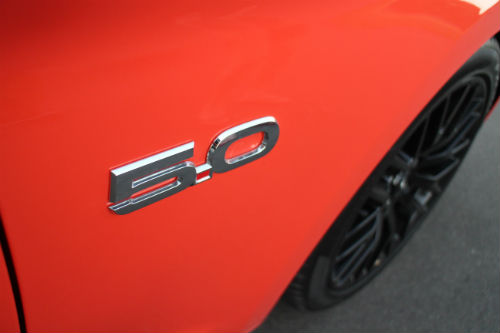
Though less usefully commodious, the Ford would feel bigger, I’d suggest. The view across that vast helipad of a bonnet is a particularly telling factor that raises awareness of that considerable width and nose length.
Still, though it’s not a car to leave much spare air in a standard-sized carpark (and you’ll want to watch the doors when opening them) visibility from behind the wheel is surprisingly good, apart from a significant over-the-shoulder blind spot. But, hey, who looks behind?
The driving position is more international than you’d anticipate, too. The standard seat is a bit squishy – the optional Recaros are preferable – but it sets up well for a good driving position.
The architecture is obviously American and so, too, the main instruments – those deep-recessed twin dials for the speedo (sorry, Ground Speed meter – gag!) and tachometer are a design signature as old as the nameplate, but not that useful.
It’s not all hokey; the central 8.0-inch touch-screen in the middle of the dash features the Sync 2 touchscreen features and functionality and is fairly easy to use while on the move. That main screen is also more useful than the secondary digital display, even though it can do all sorts of stuff, some of it is superfluous. Some is dumb. All Fords have a method of showing instant speed in a digital rendering – except this one. It displays an average speed. A gauge showing the average snowfall in Nome, Alaska, would be no more useful.
The Mustang comes with a huge amount of equipment as standard - full leather, climate control, voice-activated Bluetooth, an in-built car alarm – though the audio system isn’t exactly premium.
Ford has not scrimped on the safety kit, with up to eight airbags inside the two-door body, including an airbag mounted in the glovebox lid to protect the passenger’s knees.
Verdict
So many coupes turn out to be fleeting fashion, but the impressive order bank for Mustang suggests this Ford might, for the full duration of its first year at least, be more than a brief fling for its followers.
One powerful positive about the GT is that, while not a seriously powerful sports cars in its factory condition, it can certainly easily be retuned into that state: Those after-market specialists who have long provided extra kapow on their US market are now producing effective enhancements for right-hand-drive, at reasonable money to boot. It’s easy to understand the allure of a Roush upgrade, for instance, once you’ve heard it.
How many truly ‘new’ customers this car will attract is an open-ended question. There’s no doubt that it lays on the nostalgia pretty thickly. Those don’t ‘get’ that might not be so accepting of its foibles, which are easily spotted.
For all that, there's a certain something about the Mustang that makes it special and worthy of celebration. It's taken 50 years to arrive in fully market-acceptable format, but I'm glad it's here.


